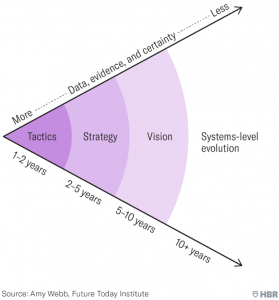The Marketing Long-Game
Thinking Big

Michael Eaton, BVK Brand+Lever Senior Vice President
Joel English, BVK Managing Partner
“Because the purpose of business is to create a customer, the business enterprise has two – and only two – basic functions: marketing and innovation. Marketing and innovation produce results; all the rest are costs.”
– Peter Drucker
As marketing professionals, we have a deep, emotional desire for Peter Drucker to be right. Sadly, that’s not the way it feels for many of us.
More commonly, the story we hear is of marketing being relegated to communications support and order fulfillment or being viewed as an expense rather than being positioned to create the value described by Drucker. Too often marketing is one of the first budgets cut to reduce expenses, and the last to have its voice heard when organizational strategy is being set.
We were reminded of that reality at a recent conference, where angst about marketing’s role was the unspoken context for a growing hope that innovative technology might help system leadership see new strategic relevance to the health care marketing discipline. The agenda was skewed to sessions on “martech stacks” that integrate data analytics and automate campaign management. Keynote addresses featured technologists. Breakouts drew large crowds interested in learning how others used data analytics to find symptomatic consumers who are ready to buy and be converted to new customers.
We, also, believe that the potential of martech is extraordinary — but it is not enough to fulfill the big idea and specific function that Drucker was referring to in his seminal statement about the purpose of the business and the centrality of marketing that requires more than precision outreach and automated messaging. It requires over-the-horizon thinking about customer creation that is central to smart enterprise decisions on brand and business strategy, operations and resource allocations.
A Futurist’s Framework for Strategic Marketing
Amy Webb is a quantitative futurist and professor of strategic foresight at the NYU Stern School of Business. In July 2019 she published an article in the Harvard Business Review titled, “How to do Strategic Planning like a Futurist”.
In her article, Webb makes the case for leaders to move away from linear strategic plans that call out the tactical “what by when”. Instead, she proposes planning around a long-view of the strategic purpose for the enterprise (our “why”) and an effort to be at least directionally correct in predicting fast-changing and future macro industry dynamics and consumer needs.
Her theory acknowledges that the further leaders push their vision into the future, the less data, evidence and certainty they have that their vision will be right. But Webb believes that it is important to have a point of view on the company’s desired future impact, and a point of view on the technological, social, financial and human forces that will shape people’s future purchase behaviors.

The application of Webb’s approach can help to structure over-the-horizon thinking about customer acquisition, and inform a roadmap for how the marketing discipline assumes a more strategic and central role on decision-making within the health care enterprise, as envisioned by Peter Drucker.
Application of the Model to Health Care Marketing
BVK recommends that marketing leadership and teams address four questions that fall out of Webb’s “strategy cone” graphic above:
| Tactics | What customer segments should we be targeting and what offerings should we redesign or create to meet predictable market needs over the next few years? |
| Strategy | How do we organize our teams and talent, and allocate marketing resources (mix) to most effectively guide value creation and customer creation over the next five years? |
| Vision | How are people’s preferences for consuming care changing, and what are the implications for what we say about ourselves and the customer experiences that we create? |
| Systems Evolution | What are the market forces, public health priorities, technology advances and broad demographic trends that will reshape who delivers care and where it is delivered? |
Consistent with Webb’s approach, the strategy cone advances as new data emerges and the macro industry and market-specific forces which shape the edges of the cone become clearer. The marketing team must remain responsive to those changes and should periodically set time aside to revisit the assumptions that define the mid-term strategies and long-term vision.
The output from this effort is highly valuable consumer intelligence and decision support for the whole enterprise on questions impacting business and operating strategies, resource allocations and talent acquisition. That output is the strategic context for brand strategy decisions, demand conversion, and automated marketing processes that deliver real, tactical advantage.
Barriers to Success
Perhaps the biggest challenge to building a strategic marketing vision is within marketing itself. It is not in the nature of most marketing teams to consider long-term vision a priority when there are so many communications and reputation management needs lining up at the door. Automating the processes for meeting those needs helps, but it does not advance the central, core management function to know the customer and translate that knowledge into critical decision-support to meet current, emerging and future customer needs. Data analysis in marketing today is more focused on precision targeting, message timing and placement (important tactical functions) as opposed to value creation and conversion.
It is our recommendation that marketing teams invest the time to build a strategic marketing roadmap that looks over-the-horizon at customer creation. Doing so will ensure marketing teams avoid what Peter Drucker identified as the risk of management over-relying on a technical, scientific approach for making decisions and losing sight of the essential questions of strategy and the needs of the customer.
…the emphasis is on techniques rather than on principles, on mechanics rather than on decisions, on tools rather than on results, and, above all, on efficiency of the part rather than on performance of the whole….
— Peter Drucker
That means less obsession about our “tech stack” and more obsession about what technology allows us to do which should be much more than demand conversion. The essence of marketing in that configuration is demand anticipation and the alignment of brand, business and operating strategies to deliver the experiences that create new customers.